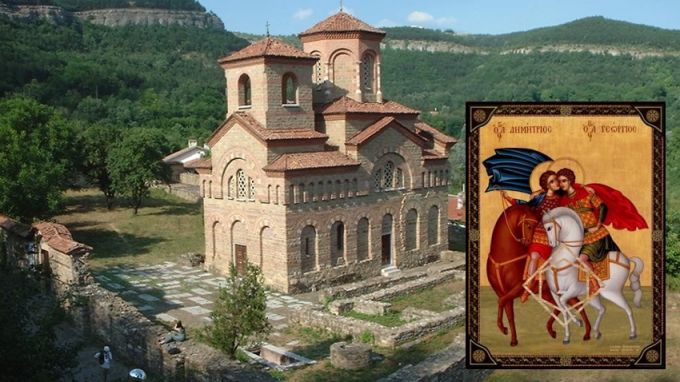
Along with traditional meals including lamb and mutton, anybody who strictly abides by traditions should prepare a chicken stew. Boiled corn, damson cheese, baked apples and pumpkin jam are also served.
There are many churches in Bulgaria named after St. Demetrius. These include the oldest medieval church in Veliko Tarnovo where the Bulgarian tsars from the Asenev dynasty were crowned – Petar, Asen and Kaloyan. Here on 26 October 1185 (on the Day of St. Demetrius) the Asenev Uprising was declared against the Byzantine yoke.
In Bulgarian folklore St. Demetrius is a courageous man with supernatural powers. To celebrate his feast he arrives on horseback bringing winter and cold, and snow falls from his beard. The feast is also linked to paying homage to the dead. According to some legends the saint is a brother of At. Archangel Michael who takes away the souls of the dead. On the Saturday before the feast (called Dimitrovden) the so-called Demetrius All Souls Day is organized. In the past, on 26 October the landlords would release from their jobs seasonal workers like farmhands, shepherds etc. hired on Gergiovden (St. George’s Feast on 6 May). To mark the end of the farming season everybody gathered for a big celebration with plenty of food.
The lyrics of an ancient folk song quoted by Bulgarian ethnographer Prof. Dimitar Marinov recount the story of the saint who together with his brother Michael put to fire Mount Athos and the monasteries there. The two were condemned and locked up for three years at the bottom of the sea. „They served three years of imprisonment and three years farmhands did not know their day, shepherds did not know their term of service and not even a drop of rain fell…“. St. Petka and St. Nedelya (who according to this song were St. Demetrius’s aunts) went to visit Our Lord and pleaded to Him to release the prisoners. However He refused with the words: “Mitre is not for release, Mitre is for extermination” (the name Mitre is a local version of Dimitar). Then the two women saints went to visit Virgin Mary and she helped for the release of Mitre.
Another legend presents St. Demetrius as the twin brother of St. George. The twins divided the year in two equal halves. St. George received the summer and St. Demetrius – the winter. This division applies to the farming year – from Gergiovden (St. George’s Feast) the spring-summer cycle of farming work begins and from Dimitrovden (St. Demetrius’s Feast) – the autumn-winter one.
Once upon a time the period around Dimitrovden was the right time to complete construction of new houses. According to the custom, a new house’s owners had to cull a ram and invite the whole village to water-bless the house. That's why builders celebrate this day as their professional day. Dimitrovden was the day to make predictions about the coming year: if the moon was full, beehives would be filled with honey and the bees would swarm. On the eve of the feast the shepherds tossed a stick in the sheepfold. If the sheep lay on it in the morning, it was believed that the winter would be long, tough and cold.
Like on St. Ignatius’s Feast (Ignazhden) predictions about the future were made depending on who would be the first guest entering a house. If he was a good and prosperous man, the year would be good for the family of the hosts too.
English Daniela Konstantinova
One frosty November morning in 1917, as World War I was raging, a Zeppelin L 59 took off from the air base near Yambol bound for Tanzania. The purpose of the flight was to deliver ammunition and materials to the German military units in a remote..
October 27 marks the 165th anniversary of the birth of Academician Aleksandar Teodorov-Balan, who was the first theorist of the Bulgarian literary language, phonetics and grammar. He was born was born in 1859 in the village of Kubey, Bessarabia...
Over 150 exhibits from 14 Bulgarian museums will take part in an exhibition entitled "Ancient Thrace and the Classical World" . The exposition will be opened on November 3 at t he Getty Museum in Los Angeles and will continue until March 3, 2025...
The Patriarchal Cathedral of St Alexander Nevsky is celebrating its temple feast today. The cathedral, a symbol of the Bulgarian capital, was built "in..
On November 24, the Bulgarian Orthodox Church honors St. Catherine (Sveta Ekaterina in Bulgarian) , who was one of the most educated women of her time...

+359 2 9336 661
